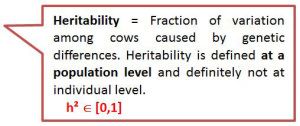Heritability
If we go back to the formula: P = G + E, with variance properties, we can write:
Var (P) = Var (G) + Var (E)
Which is equivalent to:
Var (P) = Var (A) + Var (D) + Var (E) + Var (e)
What is fundamental to understand and remember about heritability is that calculating heritability is important for predicting how a trait will respond to selection (response to selection refers to the gain in the mean of the population compared to the mean of the selected parents, see below). Hence:
A large heritability (0.5 or greater) suggests that a record on an individual is a good indicator of that individual's genetic value → Traits with high heritability are easy to improve.
A small heritability (0.15 or less) suggests that one record has some meaning in estimating genetic value, yet much is unknown about individual's true genetic value → A progeny test and pedigree analysis will help in predicting genetic value.
The table below gives values for heritabilities and genetic variance in the French Holstein breed for some interesting traits:
Traits | Heritability | Genetic variance |
|---|---|---|
Milk yield (kg) | 0.30 | 576.081 |
Fat (kg) | 0.30 | 974 |
Protein (kg) | 0.30 | 518 |
Fat content (g/kg) | 0.50 | 8.82 |
Protein content (g/kg) | 0.50 | 2.19 |
Somatic cell score | 0.15 | 0.25 |
Conception rate for cows (%) | 0.02 | 0.005 |
Interval calving to first service (days) | 0.06 | 60 |
We just saw that genetic variation is crucial to genetic progress.
The objective of genetic selection is to provide offspring which are superiors to their parents for interesting traits. Therefore, it is essential to rank and select animals based on their genetic value through genetic evaluation.








